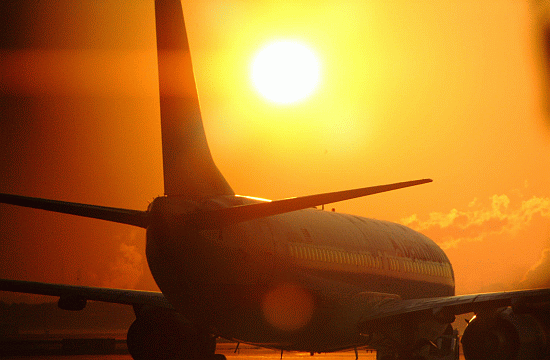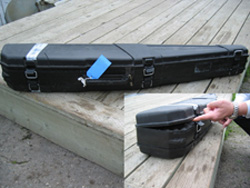How can I travel by air with my guns?
With modern security standards in place, the thought of flying with your firearms can be overwhelming. Making a mistake regarding security regulations can cause more than mere aggravation, as doing so can carry serious legal consequences. Contrary to popular belief, the rules aren’t extremely complicated. A firm grasp on these rules will allow for confident and peaceful air travel with your firearms.
First and foremost, when traveling with your firearms, be certain that your firearms are legal to posses in the state from which you depart and the state in which you will ultimately arrive. As every state and sometimes local laws differ, and those differences are beyond the scope of this discussion, be sure to conduct extensive research or consult an attorney before you travel about the gun laws in that state. In particular, pay close attention to laws regarding possession (open carry versus concealed carry), automobile travel, restrictions on magazine capacity, and types of ammunition.
In short, in order to travel with your firearms they must be (1) unloaded (2) locked in a hard case (3) declared and (4) checked. Otherwise, it may be illegal per 49 USC § 46505.
Your safe and legal travels will begin before you set foot in the airport, as you are required to store your firearms in a hard-sided case. It is important that the case you use be fairly sturdy. Cases which can be broken into even when locked will not be permitted. It’s important to recognize that a “firearms case” is neither a fail-safe option, nor your only option. For instance, it is entirely possible that your firearms case will not meet this standard, or that a case not specifically designed for firearms will meet this standard. Do not mark the case to indicate that it’s a firearm.
Once you find a suitable case, you’ll need to lock it. The rules require that only you have the ability to open the lock. This is vital. As a result, utilization of “TSA luggage locks” is likely not an acceptable method to lock firearms because entry will be accessible to somebody other than yourself. If you choose a padlock which requires a key, be sure to keep the key in your possession at all times.
Your firearm must be unloaded when you travel. According to federal regulations a firearm is loaded if it has “a live round of ammunition, or any component thereof, in the chamber or cylinder or in a magazine inserted in the firearm.” So in other words, it must be entirely unloaded. While federal regulations do not prevent you from storing a loaded magazine which is not attached to a firearm, many airlines prohibit this practice in their own policies. It is safest to store all ammunition in a manufacturer’s box in a suitcase or bag separate from your firearm.
Now that your firearm is ready to go, you’ll need to understand what to do when you get to the airport. Firearms cannot be brought onto the aircraft in carry-on bags. Items prohibited from carry-on baggage include all firearms, ammunition, firearm parts, firearm frames, receivers, clips and magazines. Be sure that you never enter the security checkpoint with any of these items, as knowingly or intentionally doing so is a violation of federal law.
Logically, if you can’t bring your firearm in a carry-on bag, you must check your firearm. When you check your firearm, you must be sure to declare that you are checking a firearm. After you do so, you will be able to proceed to your flight and meet your firearm at your destination.
To put this all into perspective, let’s discuss a hypothetical scenario. We begin in Pennsylvania, where it is legal to own and possess a handgun provided that you do not have a federal disqualifying event (outlined in 18 USC 922), and any state disqualifying event (outlined in 18 PA 6105). For the purposes of this hypothetical, this person holds a valid License to Carry Firearms in Pennsylvania. This same person is traveling to Oklahoma, where it is similarly legal to possess the same handgun, and this person has no state-based restrictions per the Oklahoma statute. Luckily, for our traveler, our Pennsylvania License to Carry Firearms is honored in Oklahoma. This person who is ready to travel stores the totally unloaded handgun and two empty magazines in a very sturdy hard case. The traveler locks the hard case (with no stickers or other notes on it that alerts someone that there is a gun inside) with a heavy padlock that uses a key to open it. The traveler places the key on his or her key chain that never leaves his or her possession. This key should not leave our traveler’s pocket except at the security checkpoint. Our traveler wants to have ammunition when he or she arrives at our destination. After all, what is the sense of concealed carry with an unloaded firearm, right? So our traveler packs four factory boxes of ammunition in his or her non-carry-on suitcase. That suitcase does not need to be locked. When our traveler arrives to the airport, he or she heads straight to the check-in counter. Once there, the traveler informs the employee assisting that he or she wishes to check an unloaded firearm. The request should not be met with any fanfare or commotion. If it does, our traveler stays calm, and simply asks for a supervisor. Our traveler considers videotaping with his or her cell phone the encounter if the treatment continues. The firearms case and the suitcase containing our ammo is checked and on its way. Our traveler goes to the TSA line. Our traveler mindful of the federal law against having any part of a firearm or ammunition to one on his or her person double checks everything (including tread of any shoes) before getting in the line. Our traveler gets to the destination and picks up the checked luggage.
One quick caveat: airlines may set their own policies and procedures when it comes to checking firearms. Our hypothetical scenario is compliant with the policies of some airlines. However, as this discussion’s focus is the law, please check with your airline regarding their policies well in advance of your travels.
American Airlines: https://www.aa.com/i18n/travelInformation/baggage/firearms.jsp
Delta Airlines: http://www.delta.com/content/www/en_US/traveling-with-us/baggage/before-your-trip/special-items.html#shooting
Frontier Airlines: http://www.flyfrontier.com/travel-information/baggage/firearms
JetBlue Airlines: http://help.jetblue.com/SRVS/CGI-BIN/webisapi.dll/,/?St=310,E=0000000000055963381,K=198,Sxi=5,Case=obj%282236%29
Southwest Airlines: https://www.southwest.com/html/customer-service/baggage/special-luggage-pol.htmll (Select “Guns and Ammunition” on the left side)
United Airlines: http://www.united.com/web/en-US/content/travel/baggage/sports.aspx
US Airways: http://www.usairways.com/en-US/traveltools/baggage/specialitems.html
As you can see, it’s not the most painful process. Law abiding gun owners don’t have to leave their guns at home if they educate themselves and take the proper precautions. For the Transportation Security Administration’s most recent statements regarding air travel with firearms, see www.tsa.gov/traveler-information/firearms-and-ammunition.




